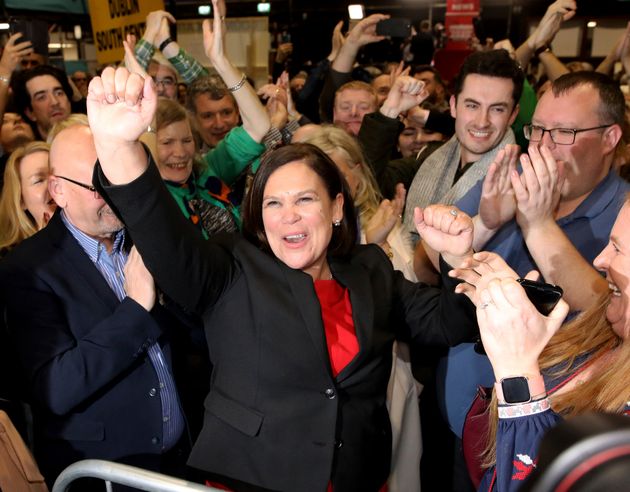Left-wing Irish nationalist party Sinn Fein has demanded to be part of the next Irish government after an election that leader Mary Lou McDonald described as a ballot box “revolution”.
McDonald vowed to work with like-minded parties to form Ireland’s next ruling coalition after a sensational performance in the country’s general election that challenges the 90-year power duopoly of Fine Gael and Fianna Fail.
While it remains unclear whether it will ultimately be part of any future government, the support gained by McDonald’s party has sent shockwaves across the Irish political landscape.
The final declaration of seats remains a long way off, but tallies suggest the party is set to top constituency polls across the country.
The party appears to be faring better than an exit poll that reported an extraordinary statistical three-way dead heat between the three main parties.
In a result symbolic of the surge, the first seat declared shortly after 4pm was Sinn Fein’s Donnchadh O Laoghaire, who topped the poll ahead of Fianna Fail leader Micheal Martin.
Fine Gael Taoiseach Leo Varadkar was also outpolled by a Sinn Fein candidate in his Dublin West constituency.
But the odds remain against Sinn Fein emerging with the most seats, primarily because it ran significantly fewer candidates than its two main rivals – 42 compared to Fianna Fail’s 84 and Fine Gael’s 82
Fine Gael and Fianna Fail have vowed never to go into government with Sinn Fein, and Fianna Fail has ruled out a “grand coalition” with Fine Gael.
If parties stick to their pledges then it would be extremely difficult for any of the three to lead a majority government.
Smaller parties such as the Greens, Labour, the Social Democrats and Solidarity/People Before Profit – and a sizeable number of independent TDs – may all be courted as the main parties seek junior coalition partners.
Arriving at the RDS count centre in Dublin, Mrs McDonald branded talk of excluding her party as “undemocratic”.
She said she had been in touch with the Greens, Social Democrats and People Before Profit to discuss the prospect of them joining her party in government.

“It’s been an election about change,” she said.
“The extraordinary thing is that it seems that the political establishment – and by that I mean Fianna Fail and Fine Gael – are in a state of denial. They are still not listening to what the people have said.
“I want us to have a government for the people. I want us to have ideally a government with no Fianna Fail or Fine Gael in it. I have started the contact with other parties to explore over the next days whether that is a possibility.
“I also have to say this, that in any event I do not accept the exclusion – or talk of excluding our party – a party that represents almost a quarter of the electorate.
“I think that is fundamentally undemocratic.”
Asked if the result marked a revolution in Irish politics, McDonald replied: “Yes, you could call it that for sure.”
Martin said he would not “pre-empt” the final outcome of the election.
He declined to rule out working with Sinn Fein but he insisted there were “significant incompatibility” issues with the party.
“Our policies, our positions and principles haven’t changed overnight or in 24 hours,” he said.
Arriving at his count centre in Cork, he said: “We will obviously listen. The people have spoken and there is no greater democrat than I, but that said we will not pre-empt the outcome itself because it’s very clear to us that the destination of the final seats in many constituencies cannot be called now.”
If overall tallies are borne out when all results are confirmed, the task of forming a coalition government looks extremely complicated.
The uncertainty created by the exit poll has even thrown up the possibility of another general election being necessary.
There are 160 seats in the Dail parliament. The speaker is automatically re-elected, leaving 159 seats up for grabs and 80 the magic number for a majority.
Vote transfers will be crucial in the proportional representation contest.
Varadkar’s last government – a minority Fine Gael-led administration that included several independent TDs – was sustained in power through a historic confidence and supply arrangement with Fianna Fail.
That landmark pact between two parties founded from opposing sides of Ireland’s civil war of the 1920s took 70 days to negotiate following the inconclusive 2016 general election.
A new confidence and supply deal cannot be ruled out – potentially a reverse of the last one, with Fine Gael supporting a Fianna Fail-led minority.
The fractured vote could yet force Ireland’s two traditional political superpowers to contemplate the once unthinkable – a grand coalition in government together.

Brexit did not feature prominently in an election campaign which was instead dominated by domestic issues like spiralling rental prices, record-breaking homeless numbers, controversy over the state pension age and a struggling health service.
The exit poll, carried out by Ipsos MRBI on behalf of The Irish Times, RTE, TG4 and UCD, suggested that only 1% of voters highlighted Brexit as their main concern.
Health (32%) and housing or homelessness (26%) were the most important deciding factors in how people voted.
Fine Gael business minister Heather Humphreys has said it was not a mistake for her party to put Brexit at the centre of its re-election strategy.
“A lot of people obviously thought Brexit is over… Brexit is far from over,” she told RTE Radio One.
“Brexit is still a big threat but some people live in the moment and a lot of people thought Brexit has gone away – it has not gone away.”
Counting, which is taking place across the state’s 39 constituencies, is expected to last at least two days.
There is a mix of three, four and five-seat constituencies.